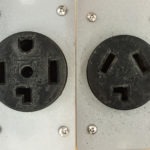
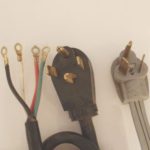 Why is a four wire dryer circuit more safe than the old, gray cord, three wire circuit? Most electricians and clients don’t know that a four wire dryer circuit, is safer than a three wire circuit. (Four wire cord out of the back of the dryer to the receptacle inside the wall, is black, with four wires, while a three wire out the back of the dryer is gray, with three wires.) Find an electrican near me for dryer circuit, oakland, piedmont, berkeley. The gray cord is a dead give away that your circuit is a dangerous three wire circuit. The three wire circuits bond the neutral to the ground of the metal case, so when the current chooses to go through you to a ground, such as a concrete wet floor, it can and will if the 120 volt circuit is pulling current to the dryer pc board or the light inside the dryer.
Why is a four wire dryer circuit more safe than the old, gray cord, three wire circuit? Most electricians and clients don’t know that a four wire dryer circuit, is safer than a three wire circuit. (Four wire cord out of the back of the dryer to the receptacle inside the wall, is black, with four wires, while a three wire out the back of the dryer is gray, with three wires.) Find an electrican near me for dryer circuit, oakland, piedmont, berkeley. The gray cord is a dead give away that your circuit is a dangerous three wire circuit. The three wire circuits bond the neutral to the ground of the metal case, so when the current chooses to go through you to a ground, such as a concrete wet floor, it can and will if the 120 volt circuit is pulling current to the dryer pc board or the light inside the dryer.
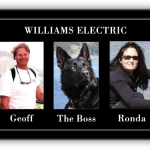
Electrician oakland ca. panel change| 510 339-5601|
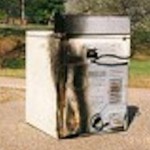
three wire dryer circuit, electrical dryer fire
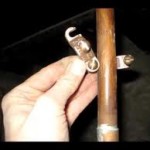
Water pipe and gas pipe bonding, grounding system
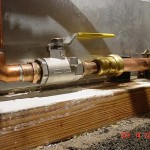
Water main bond
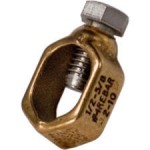
ground acorn clamp for ground rods, proper clamp

Master electrician who has changed more federal pacific panels than any other electrician
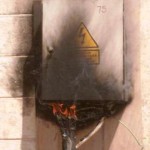
From forum: “The exception to 250.140 applies only to existing branch circuits supplying the appliances specified in 250.140. The grounded conductor (neutral) of newly installed branch circuits supplying ranges and clothes dryers is not permitted to be used for grounding the non–current-carrying metal parts of the appliances. Branch circuits installed for new appliance installations are required to provide an equipment grounding conductor sized in accordance with 250.122 for grounding the non–current-carrying metal parts.
Prior to the 1996 Code, use of the grounded circuit conductor as a grounding conductor was permitted for all installations. In many instances, the wiring method was service-entrance cable with an un-insulated neutral conductor covered by the cable jacket. Where Type SE cable was used to supply ranges and dryers, the branch circuit was required to originate at the service equipment to avoid neutral current from downstream panelboards being imposed on metal objects, such as pipes or ducts.
Caution should be exercised to ensure that new appliances connected to an existing branch circuit are properly grounded. An older appliance connected to a new branch circuit must have its 3-wire cord and plug replaced with a 4-conductor cord, with one of those conductors being an equipment grounding conductor. The bonding jumper between the neutral and the frame of the appliance must be removed. Where a new range or clothes dryer is connected to an existing branch circuit without an equipment grounding conductor, in which the neutral conductor is used for grounding the appliance frame, it must be ensured that a bonding jumper is in place between the neutral terminal of the appliance and the frame of the appliance.
The grounded circuit conductor of an existing branch circuit is permitted to be used to ground the frame of an electric range, wall-mounted oven, or counter-mounted cooking unit, provided all four conditions of 250.140, Exception, are met. The exception can be applied only where the existing branch-circuit wiring method does not provide an equipment grounding conductor. There are many existing branch circuits in which nonmetallic sheath cable with three insulated circuit conductors and a bare equipment grounding conductor was used to supply a range or clothes dryer. The bare equipment grounding conductor was simply not used because it was permitted to ground the equipment with the insulated neutral conductor of the NM cable. This “extra” conductor results because the bare conductor in a Type NM cable is to be used only as an equipment grounding conductor and cannot be used as a grounded (neutral) conductor in the same manner as is permitted for the uninsulated conductor in Type SE cable.
In addition to grounding the frame of the range or clothes dryer, the grounded circuit conductor of these existing branch circuits is also permitted to be used to ground any junction boxes in the circuit supplying the appliance, and a 3-wire pigtail and range receptacle are permitted to be used.
Exhibit 250.55 shows two examples of existing installations in which Type SE service-entrance cable is used to supply ranges, dryers, wall-mounted ovens, and counter-mounted cooking units. Junction boxes in the supply circuit are also permitted to be grounded from the grounded neutral conductor. In the bottom diagram the service-entrance cable installed from the feeder panelboard to the range or clothes dryer outlet contains an insulated grounded conductor to prevent incidental contact between the conductor and metal enclosures. Such contact could result in current being introduced onto circuit paths other than on the intended path, which is the grounded (neutral) conductor.”